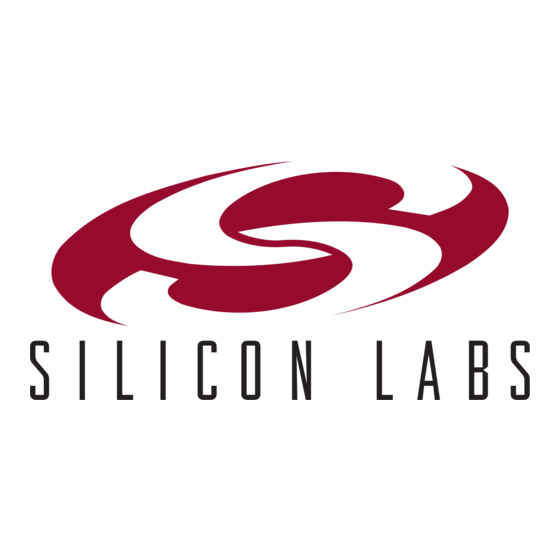
Advertisement
Quick Links
T
S
C
O O L
T I C K
A P
1. Handling Recommendations
To enable development, the ToolStick Base Adapter and daughter cards are distributed without any protective
plastics. To prevent damage to the devices and/or the host PC, please take into consideration the following
recommendations when using the ToolStick:
Never connect or disconnect a daughter card to or from the ToolStick Base Adapter while the Base Adapter is
connected to a PC.
Always connect and disconnect the ToolStick Base Adapter from the PC by holding the edges of the boards.
Avoid directly touching any of the other components.
Manipulate mechanical devices on the daughter cards, such as potentiometers, with care to prevent the Base
Adapter or daughter card from accidentally dislodging from their sockets.
Rev. 0.3 5/11
ToolStick-CapTouchSenseDC
T
S
O U C H
E N S E
Figure 1. Proper Method of Holding the ToolStick
Figure 2. Improper Method of Holding the ToolStick
Copyright © 2011 by Silicon Laboratories
D
C
A U G H T E R
A R D
U
'
G
S E R
S
U I DE
ToolStick-CapTouchSenseDC
Advertisement

Summary of Contents for Silicon Laboratories ToolStick-CapTouchSenseDC
- Page 1 Figure 2. Improper Method of Holding the ToolStick Manipulate mechanical devices on the daughter cards, such as potentiometers, with care to prevent the Base Adapter or daughter card from accidentally dislodging from their sockets. Rev. 0.3 5/11 Copyright © 2011 by Silicon Laboratories ToolStick-CapTouchSenseDC...
- Page 2 Extension Cable and may be purchased from the same link. 3. ToolStick Overview The purpose of the ToolStick is to provide a development and demonstration platform for Silicon Laboratories microcontrollers and to demonstrate the Silicon Laboratories software tools, including the Integrated Development Environment (IDE).
-
Page 3: Getting Started
One available USB port. 64 MB RAM and 40 MB free HD space recommended. 5.1.2. 3rd Party Toolsets The Silicon Laboratories IDE has native support for many 8051 compilers. The full list of natively supported tools is as follows: Keil ... - Page 4 0x0000. 5.3. Configuration Wizard 2 The Configuration Wizard 2 is a code generation tool for all of the Silicon Laboratories devices. Code is generated through the use of dialog boxes for each of the device's peripherals. Figure 4. Configuration Wizard 2 Utility The Configuration Wizard 2 utility helps accelerate development by automatically generating initialization source code to configure and enable the on-chip resources needed by most design projects.
- Page 5 ToolStick-CapTouchSenseDC 5.4. Keil µVision2 and µVision3 Silicon Laboratories Drivers As an alternative to the Silicon Laboratories IDE, the uVision debug driver allows the Keil µVision2 and µVision3 IDEs to communicate with Silicon Laboratories on-chip debug logic. In-system Flash memory programming integrated into the driver allows for rapidly updating target code.
- Page 6 ToolSt ick-CapTouchSenseDC 6. ToolStick CapTouchSense Daughter Card Memory Game Demo The ToolStick CapTouchSense Daughter Card is pre-loaded with a memory game firmware that can be played without connecting to the ToolStick Base Adapter. When disconnected from the ToolStick Base Adapter, the daughter card may be powered from the included A76 alkaline battery.
- Page 7 ToolStick-CapTouchSenseDC 6.2. Playing the Memory Game This section describes how to play the memory game using the capacitive touch sense switches on the CapTouchSenseDC. The objective of the game is to remember a sequence of lights and press the corresponding switches.
- Page 8 This section describes how to open the IDE, open and build a project, connect to a device and download the firmware. 1. Open the Silicon Laboratories IDE from the Start Programs Silicon Laboratories menu. 2. In the IDE, go to Project Open Project.
- Page 9 The CapTouchSenseDC_Memory_Game can be restored in the CapTouchSense daughter card using the following steps. 1. Close the current project or open a new instance of the Silicon Laboratories IDE. 2. Connect to the target. 3. Click the download button on the menu bar or use alt-D.
- Page 10 ToolSt ick-CapTouchSenseDC pressing the S2 switch. The blue and green LEDs will blink a few times and switch off. This indicates configuration is complete. 9. Press each of the capacitive touch sense switches to test the configuration, and finally press the S2 switch to return to the game.
- Page 11 ToolStick-CapTouchSenseDC 9. Using the CapTouchSense Daughter Card as a Development Platform The prototyping area on the ToolStick CapTouchSense Daughter Card makes it easy to interface to external hardware. All of the digital I/O pins of the C8051F931 MCU are available so it is possible to create a complete system.
- Page 12 ToolSt ick-CapTouchSenseDC 10. Capacitive Touch Sense Switches The capacitive touch sensitive switches on the CapTouchSenseDC are implemented as relaxation oscillators, with the PCB trace forming the touch-sensitive capacitive element. The relaxation oscillator is constructed using the on- chip analog comparator, on-chip resistors in the C8051F931 MCU. The on-chip analog multiplexer allows multiple switches to be operated using one comparator.
- Page 13 ToolStick-CapTouchSenseDC 12. ToolStick CapTouchSense Daughter Card Schematic Rev. 0.3...
-
Page 14: Contact Information
Silicon Laboratories products are not designed, intended, or authorized for use in applications intended to support or sustain life, or for any other application in which the failure of the Silicon Laboratories product could create a situation where per- sonal injury or death may occur.

Need help?
Do you have a question about the ToolStick-CapTouchSenseDC and is the answer not in the manual?
Questions and answers